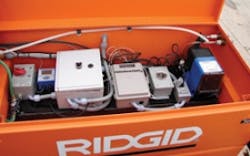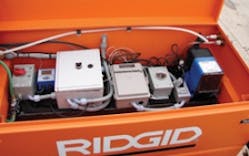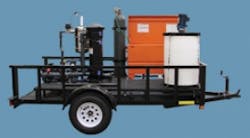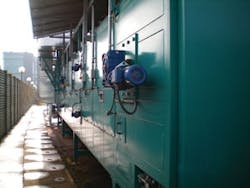By Greg Vinyard and Katrina Sanga
Tiocco Inc., a filtration systems company based in Corona, CA, was recently approached by a Southern California cement company to develop a portable and reliable filtration system for treating cement wastewater to meet environmental concerns.
Treating cement wastewater can be challenging if the right resources and technology are not available. Cement wastewater has a high alkaline pH level that is normally from 11-12 pH (the pH level of freshwater is 6-7). Because of the high alkalinity of process water in cement applications, the pH level must be lowered to meet pH requirements demanded by almost all permits. This process requires a dependable pH system to ensure that the wastewater is in fact being cleaned and standardized. Once the pH is lowered, the treated water may be used to clean cement trucks, reused, and discharged into the municipal water system.
In developing a treatment program, Tiocco needed a pH system that would be able to reliably and continuously monitor the filtration system and adjust the pH level as required. Another key requirement was ease of use and that it be maintenance free, as there were limited resources on the job site.
Tiocco turned to Sensorex, a supplier of pH systems, and selected the company’s S8000 modular pH monitoring platform along with the TX100 pH transmitter.
Compared to acid based systems often used for cement wastewater treatment, the Tiocco Filtration System uses a pH adjustment system that relies on carbon dioxide as a safer alternative. The advanced filtration system is portable and self-contained. It uses Sensorex pH monitoring to insure the treated cement wastewater meets environmental requirements.
Tiocco selected the Sensorex modular S8000 pH sensor because it is designed for heavy duty applications. It withstands extreme temperatures and harsh conditions, which are common in cement wastewater treatment. Tiocco also used the company’s Model TX100 two-wire loop powered transmitter with the pH sensor configured for a 4-20mA output.
The same Sensorex S8000 pH/ORP electrode can be used in either tank submersion or in-line mounting applications to measure pH, as well as HF resistant pH, ORP (REDOX) or low ionic pH. Its electrode design incorporates double junction ERP technology, which provides a complex path to protect the reference in the presence of interacting ions such as proteins, silver and sulfides that interact with silver or chloride. High temperature reference gels also protect against thermal breakdown.
The S8000 sensor cartridge is constructed with heavy-duty Ryton® (PPS) parts and Viton® seals in a chemically resistant body to ensure consistently accurate measurement. The sensor design’s flat surface self-cleaning technology means less maintenance throughout the life of the product, especially in turbulent flow.
The sensor electrode measures a pH range from 0-14 (0-12.3 pH with low Na+ ion error) at a pressure range of 0-100 psig de-rated under temperature. It operates over a temperature range of 0-100°C de-rated under pressure or 0-80°C when mounted in flow cell or 0-70°C with an electronic module. An optional ORP Redox Electrode measures -1000mV to +1000mV. The optional HF resistant pH electrode measures 0-12 pH at 0-50°C.
The complete S8000 platform includes a choice of mounting interface hardware for inline installation or tank submersion. A choice of interface and adapter modules is available, including with or without solution grounds and automatic temperature compensation.
Optional electronic modules for applications requiring more than a direct electrode output are available for battery powered unity gain amplification (to extend signal distance), for a battery-powered differential amplifier (to solve ground loop issues and extend signal distance) and for a blind two-wire 4-20mA transmitter.
About the Authors: Greg Vinyard is an Application Specialist, Tiocco Inc. and Katrina Sanga is an Application Specialist with Sensorex.





